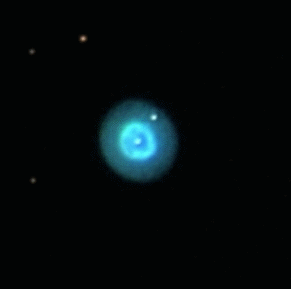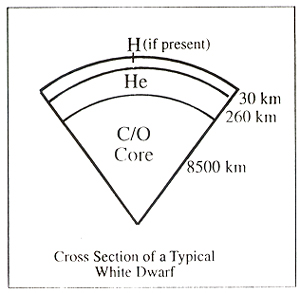


| Home Page | Overview | Site Map | Index | Appendix | Illustration | About | Contact | Update | FAQ |
 |
 |
 |
When a star with mass less than 5 Msun reaches the end of its life, it casts off its gaseous outer-envelope at high speed (1000-2000 km/sec) and leaves behind a planetary nebula as shown in Figure 08-10 (click on image to obtain larger view). The one on the left is the side view in bipolar appearance, while the Helix |
Figure 08-10 |
Planetary Nebulae |
Nebula in the middle is the end-on view. The right image shows ten different planetary nebulae in a |
 |
The shrinking core of a low mass star cannot contract far enough to raise its temperature high enough for carbon burning to commence. No further thermonuclear energy generation is possible. The shrunken remnant becomes a white dwarf with a size comparable to the Earth and is composed predominantly of carbon and oxygen. The structure is supported by electron degeneracy pressure. The matter in the white dwarf is packed very tight (up to 3x107 gm/cm3 in the core) in layers (see Figure 08-11). Under such conditions of high density the atomic electrons are no longer attached to individual nuclei. The electrons are ionized and form an electron gas. In the absence of nuclear energy sources, the star cools down, but, because degeneracy pressure is unaffected by the decreasing temperature, the cooling white dwarf does not contract. It instead continues to cool and to fade away gradually. Over ten billions years or more it will eventually evolve to become a cold dark |
Figure 08-11 White Dwarf [view large image] |
body called a black dwarf. This process takes so long that there has not been enough time since the origin of the universe for any star to reach the black dwarf state. Table 08-03 compares the properties of the Sun, the Earth, and Sirius B - a typical white dwarf. |
| Property | Sun | Earth | Sirius B |
|---|---|---|---|
| Mass (Msun) | 1.0 | 3x10-6 | 0.94 | Radius (Rsun) | 1.0 | 0.009 | 0.008 | Luminosity (Lsun) | 1.0 | 0.0 | 0.0028 | Mean Density (gm/cm3) | 1.41 | 5.5 | 2.8x106 | Central Density (gm/cm3) | 160 | 9.6 | 3.3x107 | Surface Temperature (oK) | 5770 | 287 | 27000 | Central Temperature (oK) | 1.6x107 | 4200 | 2.2x107 |